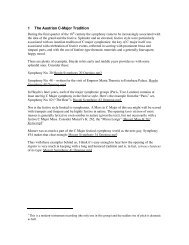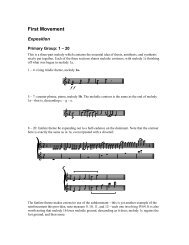Mozart Symphony No. 39 (PDF) - Scott Foglesong
Mozart Symphony No. 39 (PDF) - Scott Foglesong
Mozart Symphony No. 39 (PDF) - Scott Foglesong
Create successful ePaper yourself
Turn your PDF publications into a flip-book with our unique Google optimized e-Paper software.
It is later, under the influence of the fine wind playing encountered in Vienna, that <strong>Mozart</strong> will<br />
bring the clarinet into the full sphere of orchestral symphonic playing; the later symphonies do<br />
not have disposable clarinet parts, and in the E-flat symphony <strong>Mozart</strong> goes so far as to do away<br />
with oboes altogether and give the clarinets some of the most important expressive material in the<br />
wind section.<br />
2.4.2 <strong>Mozart</strong>’s Expansion of the Woodwinds<br />
It is very important to remember that a composer who wrote important passages for winds during<br />
this period was really asking for trouble in a lot of ways. Winds were, in fact, very unreliable<br />
during this period. Consider this passage by J.-J. Momigny in 1818 (!) about the use of wind<br />
instruments: here he is discussing a passage in the first movement of Haydn’s <strong>Symphony</strong> #104, in<br />
which a flute and two oboes play alone for eight bars (bars 9 – 16 of the recapitulation). He says:<br />
It is necessary to admit that, even though Haydn wisely took all the precuations that could lessen the danger<br />
of such an undertaking, he had hardly reason to be pleased with himself at having handed over the reins of<br />
the symphony for eight bars to three wind instruments, which at very least have the inconvenience of never<br />
being perfectly in tune, even if they have the good luck to be unintimidated and to carry on with aplomb.<br />
The warmth of the hall or a drop of water in the instrument can upset the most able artists [on these<br />
instruments], and make a blemish on the brilliant and royal robe of the symphony.<br />
<strong>No</strong> composer is more on guard against these unfortunate accidents than the great Haydn. His wind<br />
instruments are always polished with an unequalled care. <strong>Mozart</strong>’s are sometimes more haphazard, and if the<br />
tempo is even a little accelerated, then you can see them lose their effectiveness.<br />
As an example of the above, consider this little moment from the John Eliot Gardiner/English<br />
Baroque Soloists recording of the E-flat symphony. Excellent players, first-rate. But there is one<br />
passage from measures 65 – 67 in which there is a nearly impossible bit of intonation with period<br />
instruments. They do better than almost any ‘period’ group on Earth, but on the second beat of<br />
measure 66 there is still a moment that curls the hair: II - 65 - 68.mp3<br />
2.4.3 First Movement<br />
2.4.3.1 Second Theme<br />
The wind choir actually finishes up the phrase—this kind of cutting-and-dividing of melodies is<br />
definitely one of <strong>Mozart</strong>’s orchestral practices that was admired by many. Also it was copied with<br />
varying effects by other composers; I came across one musical writer griping about young<br />
composers nowadays ripping their melodies into little patches in order to orchestrate them à la<br />
<strong>Mozart</strong>, except that they weren’t doing it well. I - 98 - 119.mp3<br />
The closeness between flutes and clarinets (remarked above) is demonstrated again by the use of<br />
the flute to actually finish the clarinet’s melody: I - 106 - 109.mp3<br />
2.4.3.2 Retransition<br />
The winds play quite an important role in the retransition to the recap. (I’ve noticed this in other<br />
<strong>Mozart</strong> works like the G-minor symphony.)<br />
A solo wind choir finishes the retransition—no strings at all: I - 181 - 183.mp3<br />
In approaching this retransition, the winds come into prominence, probably as a preparation for<br />
this solo passage. In measures 172, 174, and 176 the violins are moved to a low area in their<br />
registers, giving the high winds a chance to be heard—the flute in particular. This is something<br />
that might be lost on modern instruments, but comes out beautifully in a period performance. I -<br />
168 - 185.mp3





